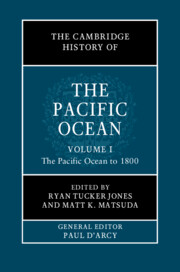Book contents
- The Cambridge History of the Pacific Ocean
- The Cambridge History of the Pacific Ocean
- The Cambridge History of the Pacific Ocean
- Copyright page
- Contents
- Figures
- Tables
- Contributors to Volume I
- Frontispiece
- General Editor’s Introduction
- Preface to Volume I
- Part I Rethinking the Pacific
- Part II Humans and the Natural World in the Pacific Ocean
- 6 Indigenous Knowledge/Science of Climate and the Natural World
- 7 The Birth and Development of Pacific Islands to 1800 ce
- 8 Atolls, Experiments, and the Origin of Islands
- 9 Natural Hazards, Risks, and Peoples in the Pacific World
- Part III Deep Time: Sources for the Ancient History of the Pacific
- Part IV The Initial Colonization of the Pacific
- Part V The Evolution of Pacific Communities
- Part VI Europe’s Maritime Expansion into the Pacific
- References to Volume I
- Index
6 - Indigenous Knowledge/Science of Climate and the Natural World
from Part II - Humans and the Natural World in the Pacific Ocean
Published online by Cambridge University Press: 11 November 2022
- The Cambridge History of the Pacific Ocean
- The Cambridge History of the Pacific Ocean
- The Cambridge History of the Pacific Ocean
- Copyright page
- Contents
- Figures
- Tables
- Contributors to Volume I
- Frontispiece
- General Editor’s Introduction
- Preface to Volume I
- Part I Rethinking the Pacific
- Part II Humans and the Natural World in the Pacific Ocean
- 6 Indigenous Knowledge/Science of Climate and the Natural World
- 7 The Birth and Development of Pacific Islands to 1800 ce
- 8 Atolls, Experiments, and the Origin of Islands
- 9 Natural Hazards, Risks, and Peoples in the Pacific World
- Part III Deep Time: Sources for the Ancient History of the Pacific
- Part IV The Initial Colonization of the Pacific
- Part V The Evolution of Pacific Communities
- Part VI Europe’s Maritime Expansion into the Pacific
- References to Volume I
- Index
Summary
Australian Aboriginal peoples have had some of the longest continuous interaction with local landscapes and seascapes on Earth, stretching back at least 60,000 years across much of Australia, and much earlier for the first settlement in the far north. To survive and thrive across such diverse landscapes required intimate knowledge of varied flora and fauna, keen and precise observation of variation in behaviour and climate, both seasonally and over longer time scales. It also requires a different understanding of human relationships with the elements of the environment; species movement, behaviours, and phenology, along with weather or sky indicators in seasonal change, are the primary indicators for Indigenous knowledge relating to food and medicine resources, cultural continuation, and inter-generational knowledge transfer. Many species also form a connection to cultural landscape interpretations, along with the attachments to totemic and identity species. These species are also seen as kin and are represented as such through kinship lineages and within storylines through animism. These and more cultural variables are at risk from human-induced climate change, through seasonal fluctuations and species responses, particularly as they relate to local knowledge based on ecological cyclic processes and social constructs. This knowledge and the systems around it (law, storylines, behaviours, environmental indicators, etc.) are referred to as traditional ecological knowledge (TEK). However, TEK also offers an effective means of adjusting to the current challenges of climate change.
- Type
- Chapter
- Information
- The Cambridge History of the Pacific Ocean , pp. 127 - 148Publisher: Cambridge University PressPrint publication year: 2023
- 1
- Cited by



